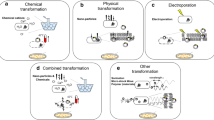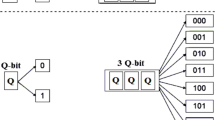Abstract
Paraquat-resistant variants were isolated in Chinese hamster ovary (CEO) cells by stepwise increases in paraquat concentrations. Three series of selective experiments gave variants which appeared to be using one or several different mechanisms of resistance. In all variants tested (PQ-1, PQ-2, PQ-3, PQ-2X and PQ-3X of series 1), radioactively labeled paraquat was taken up by the cells. These variants exhibited no unusual resistance to either oxygen or radiation, nor were increases found in the activities of free-radical scavenging enzymes. They had extra DNA (3–12%) and an unusual acrocentric marker chromosome which was common to all of the variants but never observed in the parental cells. Double minutes were observed in 29% of metaphases of the PQ-3 variant. One of the resistant lines exhibited evidence of an intrinsic chromosomal instability, a phenotype that could conceivably facilitate gene amplification. Selection series 2 and 3 were designed to further evaluate gene amplification as a mechanism of resistance. These variants exhibited high frequencies (40–100%) of tetraploidy or hypotetraploidy with loss of chromosomes and varying frequencies of double minutes (10–75% of metaphases). In two of the variants the same marker chromosome which was observed in the series 1 variants was seen. Two other lines exhibited a variant of this marker, incorporating it into a metacentric chromosome. It may be that gene amplification facilitates resistance to paraquat and that both stable and unstable methods of amplifying genes are used.
Similar content being viewed by others
Literature cited
Bus, J.S., Aust, S.D., and Gibson, J.E. (1974).Biochem. Biophys. Res. Commun. 58:327–331.
Fridovich, I. (1978).Science 201:875–880.
Puck, T.T., Cieciura, S.J., and Robinson, A. (1958).J. Exp. Med. 180:945–956.
Lowry, O.H., Rosebrough, N.J., Farr, A.L., and Randall, R.J. (1951).J. Biol. Chem. 193:265–275.
Marklund, S., and Marklund, G., (1974).Eur. J. Biochem. 41:469–414.
Beers, R.F., Jr., and Sizer, I.W. (1952).J. Biol. Chem. 195:133–140.
Rathburn, W.B., Hough, M., Gruber, L., and Harris, J.E. (1978).Interdiscip. Top. Gerontol. 12:132–140.
Campbell, C.E., and Worton, R.G. (1977).Cytogenet. Cell. Genet. 19:303–319.
An International System for Human Cytogenetic Nomenclature (1978), ISCN. (1978).Cytogenet. Cell Genet. 21(6):1–404.
Cowell, J.D. (1982).Annu. Rev. Genet. 16:21–59.
Rabinovitch, P.S., Martin, G.M., and Hoehn, H. (1982).Hum. Genet. 61:246–249.
Carmines, E.L., Carchman, R.A., and Borzelleca, J.F. (1981).Toxicol. Appl. Pharmacol. 58:353–362.
Bus, J.S., Aust, S.D., and Gibson, J.E. (1977). InBiochemical Mechanisms of Paraquat Toxicity (ed.) Autor, A.A. (Academic Press, New York), pp. 157–174.
Michaelis, L., and Hill, E.S. (1933).J. Am. Chem. Soc. 55:1481.
Ledwith, A. (1977). InBiochemical Mechanisms of Paraquat Toxicity (ed.) Autor, A.A. (Academic Press, New York), pp. 21–38.
Biedler, J.L., Melera, P.W., and Spengler, B.A. (1980).Cancer Genet. Cytogenet. 2:47–60.
Bostock, C.J., and Clark, E.M. (1980).Cell 19:709–715.
Cowell, J.K. (1981).Cancer Res. 41:1508–1517.
Wahl, G.M., Vitto, L., Padgett, R.A., and Stark, G.R. (1982).Mol. Cell. Biol. 2:308–319.
George, D.L., and Franke, U. (1980).Cytogenet. Cell Genet. 28:217–226.
George, D.L., and Powers, V.E. (1981).Cell 24:117–123.
Joenje, H., Gille, J.J.P., Oostra, A.B., and van der Valk, P. (1985).Lab Invest. 52:420–428.
van der Valk, P., Gille, J.J.P., Oostra, A.B., Roubos, E.W.T., Sminia, T., and Joenje, H. (1985).Cell Tissue Res. 239:61–68.
Stark, G.R., and Wahl, G.M. (1984).Annu. Rev. Biochem. 53:447–491.
Author information
Authors and Affiliations
Rights and permissions
About this article
Cite this article
Starr, J., Sela, S., Disteche, C.M. et al. Resistance to paraquat in a mammalian cell Line. Somat Cell Mol Genet 12, 141–152 (1986). https://doi.org/10.1007/BF01560661
Received:
Revised:
Issue Date:
DOI: https://doi.org/10.1007/BF01560661




